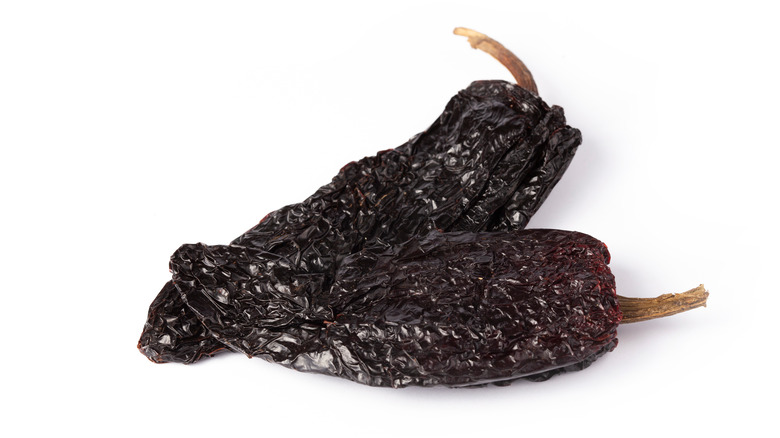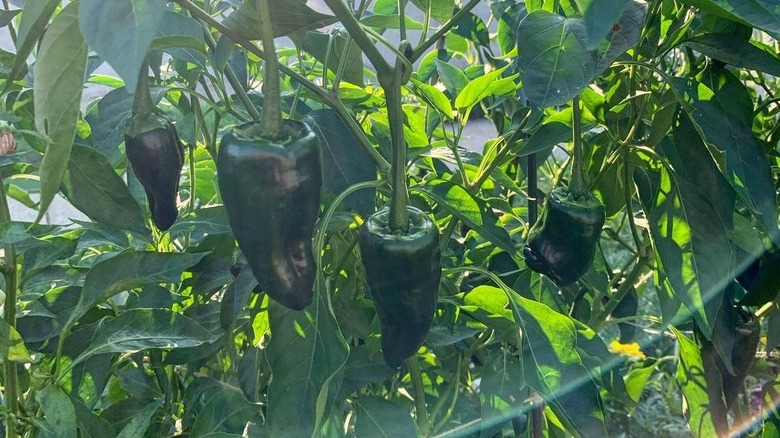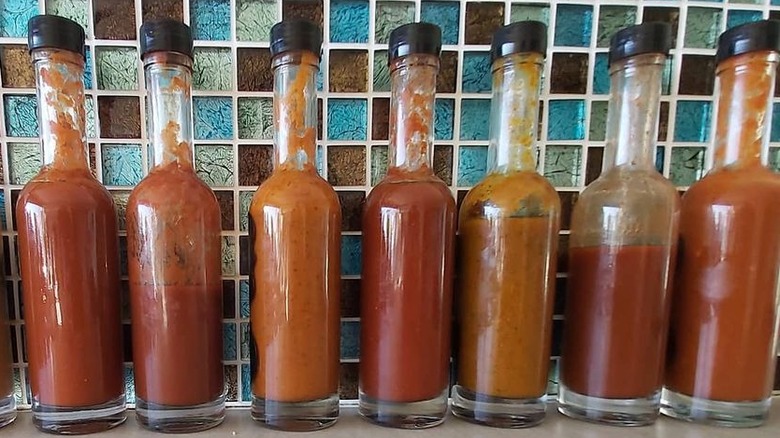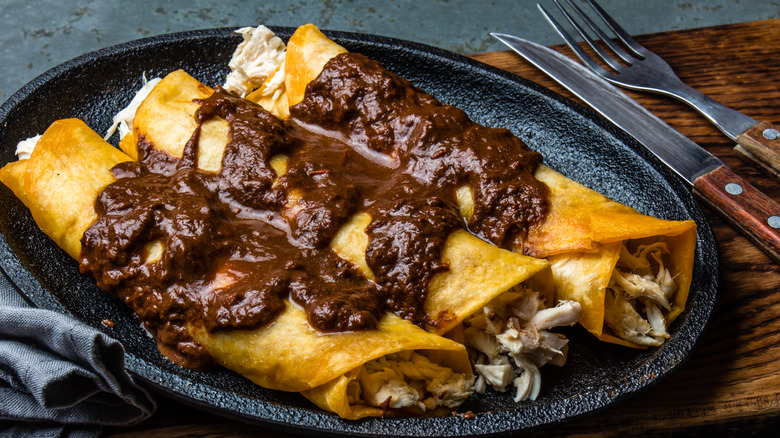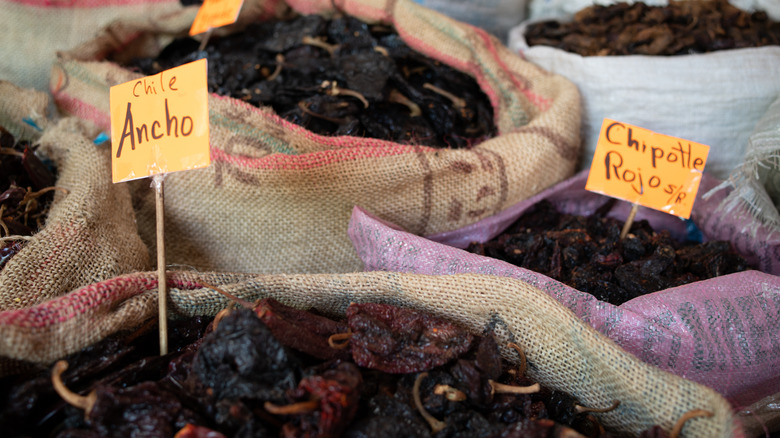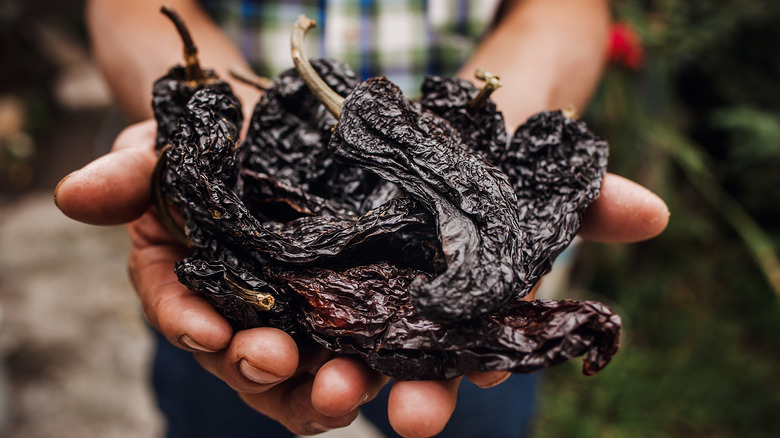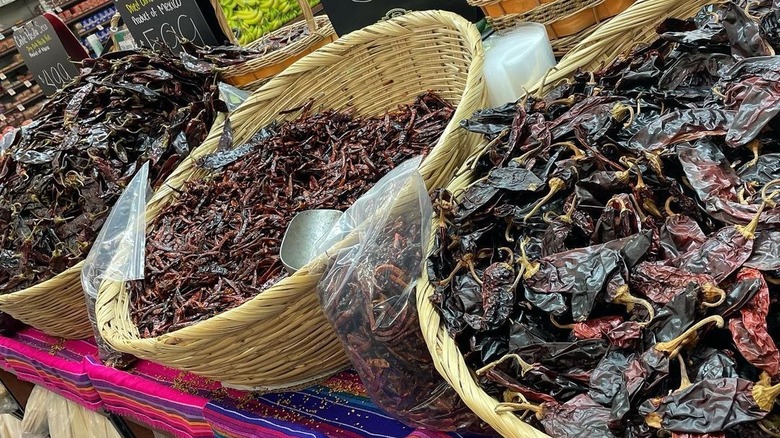What Is An Ancho Chile Pepper And What Does It Taste Like?
We may receive a commission on purchases made from links.
Searching for a way to spice up your favorite dishes without burning your tastebuds? Look no further than the rich chocolatey flavor, stimulating aroma, and mild heat offered up by the ancho chile pepper.
Hailing from Puebla, Mexico, the ancho chile (Capsicum annuum) is a fully ripened and dried poblano pepper that is a member of the Solanaceae or nightshade family, according to Specialty Produce. The ancho is classified as a fruit produced by a flowering plant with internal seeds typically dispersed by animals and birds who eat them despite their fiery nature, says A Spicy Quest.
According to The Spruce Eats, this chile has a broad width compared to other peppers and earned its name from the Spanish word "ancho," which means "wide." A poblano pepper is picked when it is a deep green color, but when allowed to stay on the vine and fully ripen, it develops a sweeter flavor and darker red color that is the signature of the ancho chile. Once harvested and dried, it takes on a deep mahogany color and flattens into a wrinkled, almost heart-shaped pepper that is just waiting to impart its sweet, smoky spice to your meal.
Where is the ancho chile pepper grown?
Ancho chiles are traditionally cultivated in warm areas in the Western Hemisphere, such as Central and South America, Mexico, and the West Indies (via Britannica). According to Chile Peppers, California and other Southwestern U.S. states have also started growing a variety of chiles and bringing them to the market nationwide.
Poblano peppers are the unripened, fresh form of the ancho pepper. Typically grown throughout the spring and summer, poblanos like warm, enriched soil and full sunlight, according to Gardening Know How. The poblano is usually harvested in August or September when it reaches four to six inches in length and develops a dark green hue — but when left on the vine to ripen, its color deepens to a blackish-red and its flavor characteristics change to feature enhanced sweetness and milder heat. Now it's ancho time.
Specialty Produce says that the fully ripened poblano is then cut from the plant and laid out to dry in the sun over a few weeks, resulting in what we know as the ancho chile pepper.
What does the ancho chile taste like?
Although the ancho is considered mild in heat, it's still a pepper, and it won't hesitate to remind your tastebuds of that fact when you eat them. Chili Pepper Madness tells us that peppers get their heat from a natural chemical compound called capsaicin. According to Just Enough Heat, a pepper's spice level can be measured on the Scoville Scale, created by Wilbur Scoville.
The test is conducted by sampling capsaicin from a particular pepper and then measuring how much it needs to be diluted before taste testers can no longer feel the burn. For reference, the Trinidad Scorpion Pepper currently holds the record, with a mouth-melting 1.4 million Scoville units, whereas the friendly ancho comes in at roughly 1,000-2,000 units (per another article on Chili Pepper Madness). So, the ancho's got kick, but you don't have to worry about steam coming out of your ears when eating them.
Where the ancho really packs a punch is in its layers of rich flavors. The chocolatey sweetness that develops while the pepper is ripening on the vine is perfectly balanced by deep earthy undertones. Its mild spice is complemented by fruity notes, reminiscent of prunes or raisins, that play off each other and enhance the pepper's flavor profile (via The Spruce Eats), meaning this pepper has flavor for days.
The best ways to cook with ancho chiles
When cooking with ancho chile peppers, there are a few helpful tips to aid them in releasing their full flavor potential. MasterClass recommends removing the chile's seeds and stems and then enhancing their flavor by roasting them in a dry pan or warm oven. Rehydrating chiles in hot water for 30 minutes can also soften their flesh, adds MasterClass, which can make blending and pureeing easy for soups and sauces. Culinary Hill also suggests using a spice grinder to make homemade ancho chile powder that can be a full-flavor addition to any spice cabinet. Once the dried ancho pepper's delectable flavors are unleashed through these methods, the cooking options are endless.
Mole is one of the most iconic and delicious Mexican sauces made from ancho chiles, according to Cocina Corazón. Mole sauce contains over 20 ingredients, including various herbs, spices, peppers, and Mexican chocolate. It takes a flavorful pepper to stand out in that mixture, and the ancho chile pepper steps up to the plate and lets its smoky, fruit-forward flavor profile really shine. When pureed, ancho chiles lend their earthy sweetness to enchilada sauces and spicy soups, too. The fruity spice of ancho chile powder also adds depth to marinades, rubs, and vegetables, and can even bring a surprise element to fruit salads and hot chocolate.
Where can you buy ancho peppers?
Thrive Cuisine says that the best places to find ancho chiles at the grocery store will be in the spice aisle or in with the international foods section. You can usually find powdered anchos in the spice section, and whole dried peppers are usually hanging in the Latin foods area or near the produce department. You can often find dried and powdered ancho peppers sold in bulk or by the dozen if you have a local Latin market nearby. Online retailers, like Melissa's, also offer an abundance of ancho buying options with affordable shipping since the dried or ground peppers are so lightweight.
When buying dried chiles, The Spice House recommends choosing peppers that have a slight bend in them and don't flake into dust. Ground and whole dried ancho chiles should have a delicious aroma that is rich, earthy, and sweet. Because these peppers are sold dried or powdered, they are widely available year-round. When you bring them home, keep them in an airtight container to prolong their shelf-life and safeguard their flavor.
Nutritional information about ancho chiles
Adding chiles to your diet might spice up your health as much as it does your favorite dishes. Ancho peppers are not only full of vitamins and antioxidants, they might also have some anti-inflammatory properties as well.
Ancho chile peppers are full of flavor and packed with vitamins and antioxidants that might have significant health benefits (even Alex Guarnaschelli is a fan of them for this reason). According to Healthline, free radicals are molecules that wreak havoc on our cells when ingested, but the vitamin C, capsaicin, and carotenoids found in ancho chiles are antioxidants that may be effective in fighting illnesses and further cell deterioration. Our cardiovascular and immune systems are also thought to greatly benefit from antioxidant-rich foods like peppers.
Capsaicin, the very thing that gives peppers their heat, may also provide relief for folks who have inflammatory issues, says WebMD. This powerful pepper compound reacts with receptors in our bodies and desensitizes them to provide pain relief to arthritic joints and aching muscles. When consumed, the capsaicin in chile peppers may inhibit substances in our bodies that cause inflammation, according to Spice Sherpa. Studies have also shown capsaicin to have some promising anti-cancer properties as well, although more research is needed. Adding anchos to make a flaming hot meal not only tastes great, but might also put out the fire in an achy back and boost the immune system.
Varieties and substitutes for ancho peppers
Chiles can add rich earthy flavors, mouth-watering spice, and enticing aromas to dishes that need to be kicked up a notch, and there are endless varieties to fit your fancy. If the ancho chile is your pepper of choice, but you can't get a hold of it, there are some other varieties and substitutions that might help you out in a pinch.
The Spruce Eats tells us that the fully ripened poblano produces two types of dried chiles, the ancho and mulato. The mulato is a poblano pepper left to ripen on the vine even longer than the ancho until it reaches a dark brown color before being dried. It has similar flavor notes of chocolate and earthy spices, but with a hint of licorice that sets it apart from the ancho. A solid substitute for ancho chile powder is also mild paprika, as it has a similar heat level balanced with sweet undertones.
When you're in the market for a pepper that boasts a complex combination of fruity, smoky, spicy, and sweet elements, don't hesitate to reach for the ancho chile pepper. Its unique flavor profile and mild heat won't disappoint.
